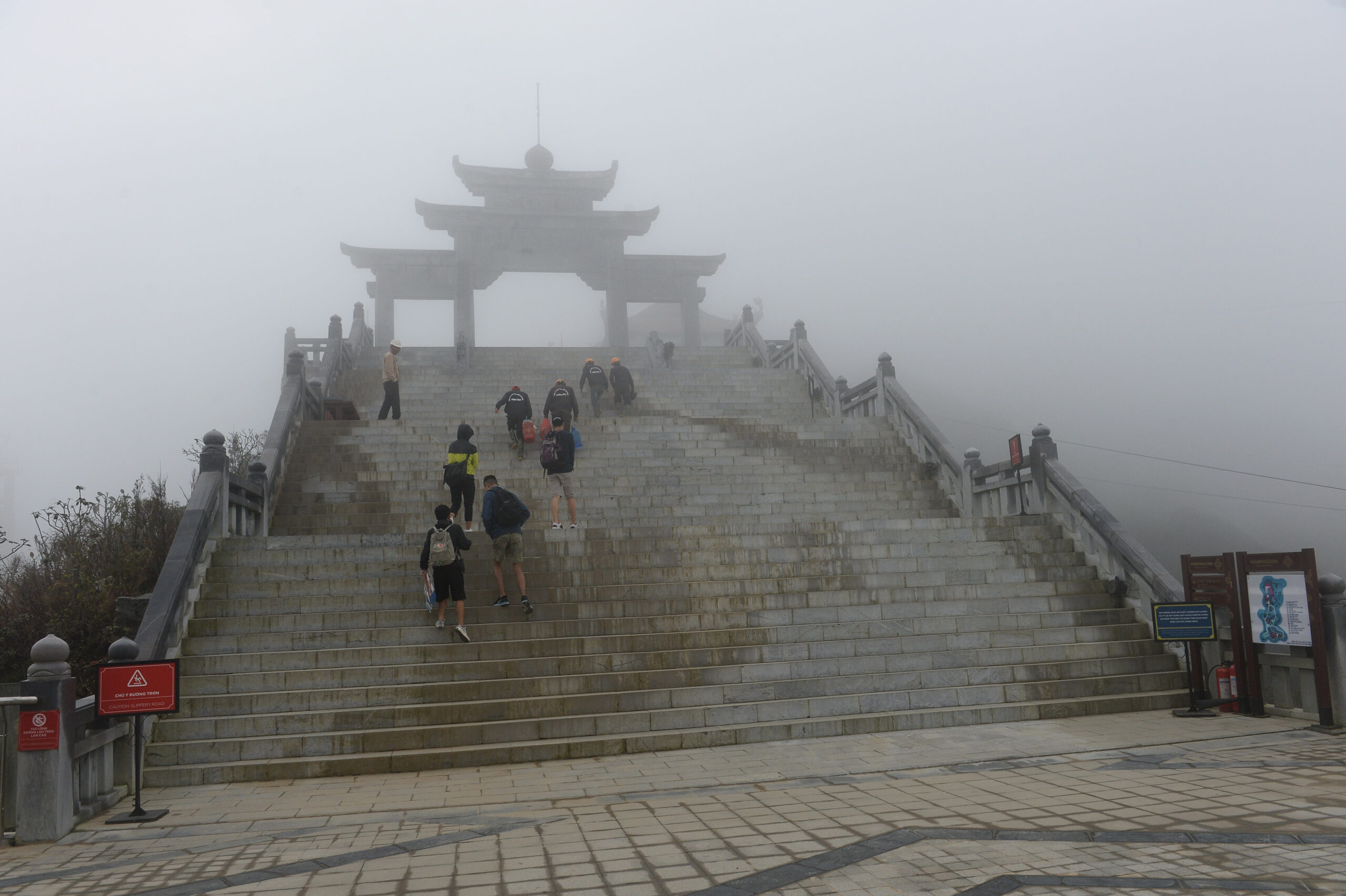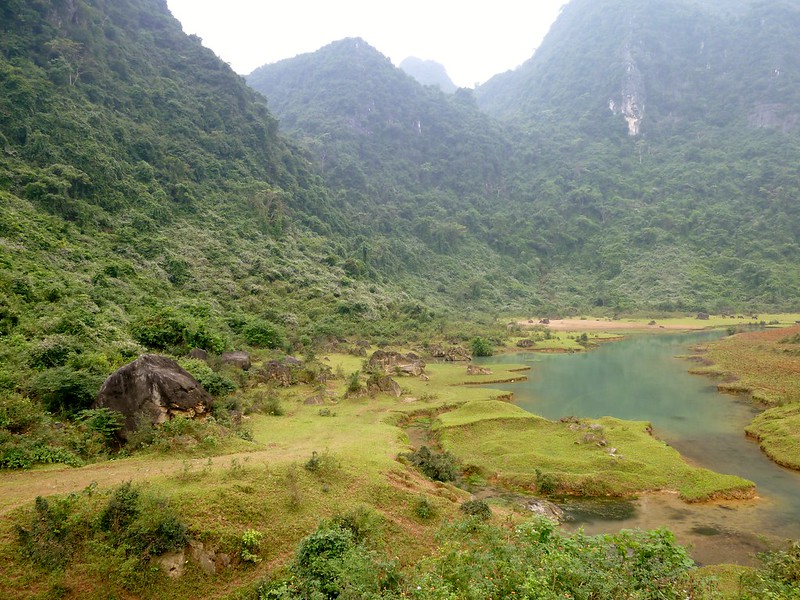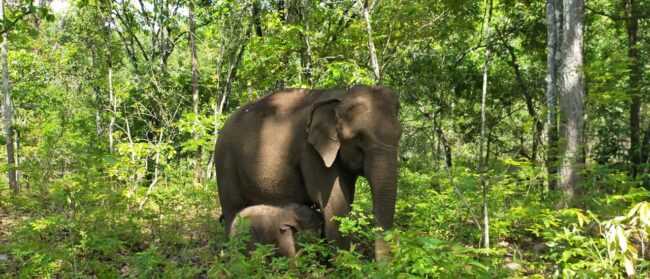Vietnam’s first cable car was spearheaded by the country’s first billionaire: Pham Nhat Vuong. Seven pylons designed to look like the Eiffel Tower pop out of the bay off the coastal city of Nha Trang and connect gondola-laden cables to Hon Tre Island. At night, the towers light up neon.
Vuong is the founder and chairman of Vingroup, the country’s largest private company. The Vinpearl Land resort on Hon Tre Island was his first big project. The cable car carrying passengers to the island beginning in 2007 ignited a race among the country’s leading corporations to build aerial lifts.
But the cable-car craze represents something bigger than the sum of the concrete pillars, steel, cables and glass. The rapid development showcases how giant conglomerates are carving out space on Vietnam’s coasts and mountains for resorts and tourism complexes that some argue negatively impact the environment and have little benefit for local communities.
Cable cars are often key features of these projects and enable thousands of people daily to visit some of the country’s most environmentally tenuous locales. Land is often cleared for construction and the high-volume of tourists shuttled to now easily accessible destinations leads to waste buildup, putting pressure on the ecosystem.
Hoang Nguyen, director of Handspan Travel Indochina, used to take tour groups on overnight treks to the top of Fansipan, the tallest mountain in Vietnam and neighbouring Cambodia and Laos. Since 2016, a cable car built by real estate developer Sun Group can reach the peak in about 20 minutes, carrying 2,000 people per hour. Sun Group is a major player in tourism construction and has built six of the country’s cable cars.
Nguyen claimed there is now a “huge problem with trash” and issues with the mountain’s sewage system. And while a few cable cars could positively impact tourism in Vietnam, he asserted, the current rate of development is unsustainable.
“All the projects are really big and from my point of view, leave a very strong effect on the environment,” Nguyen said. “The problem with Vietnam is that we have too many… and they are building more.”
Ken Atkinson, vice chairman of Vietnam’s Tourism Advisory Board, said developers saw the success of the Nha Trang cable car and rushed to get a piece of the pie.
“The first one to Vinpearl Land, that was quite successful. That of course prompted further development,” he said. “Nobody wants to be left behind.”
In addition to the cable cars in Nha Trang and Fansipan, travellers can take air lifts on Cat Ba Island and look down on karst formations while shuttling across Ha Long Bay in the North. In central Vietnam, tourists can take a ride over tree-covered hills in Dalat and around multiple routes of a resort complex near Danang. Moving southward, there are cable cars running to Ta Cu Mountain in Phan Thiet, Ba Den Mountain near the Cambodian border, a mountaintop amusement park overlooking the sea in Vung Tau and another from Phu Quoc Island to a cable car station and shopping hub modelled after ancient Rome on the small island of Hon Thom.
Deputy Prime Minister Le Van Thanh approved a cable car project this year connecting two pagodas in Hanoi and neighbouring Hoa Binh Province. There also are plans to build a gondola lift to Mau Son Mountain in northern Lang Son Province. Cable cars are likely to be features of large resorts planned for Vietnam’s coast: MerryLand in Binh Dinh Province and NovaWorld in Binh Thuan Province.
“There can be a tendency to overdo things,” Atkinson said. “There could be more thought given to the environment and the ability of the destination to cope with the volume of people that the cable cars are actually transporting.”

Despite the many gondola lifts in operation, one development project was halted after public outcry.
Sun Group sought approval to build a cable car in Phong Nha-Ke Bang national park in 2014. The park is home to Hang Son Doong, the world’s largest cave system. The caves have multiple climates, enough space to hold an airplane and a New York-city block and are home to seven eyeless creatures discovered since the system was first scientifically explored in 2009.
The cable car could have brought 1,000 visitors per hour into the cave’s delicate ecosystem daily. In October 2014, a Facebook page called ‘Save Sơn Đoòng’ became an outlet for thousands of objections to the cable car.
Although Sun Group scrapped the plan, the conglomerate FLC Group received approval in 2017 for construction of a cable car to nearby En Cave in the same park, although development never took off. Unrelated to the project, FLC’s chairman was arrested last month for stock market manipulation.
Bui Huyen Trang first became concerned about the environment 15 years ago after finding beaches covered in trash near her hometown, the northern port city of Hai Phong. She expressed discontent on the ‘Save Sơn Đoòng’ page about Sun Group’s ongoing construction of a tourism complex in northern Tam Dao National Park.
“Our voices condemning the construction of the cable car in Son Doong or similar places have not been heard much,” Trang said, noting that although Phong Nha-Ke Bang remains free of cable cars, future tourism development still looms. “The projects will only be temporarily stopped, not cancelled.”
Sun Group cable cars and surrounding structures have already threatened vulnerable species in Vietnam and are degrading the environment, Trang said.
She pointed to Sun World Ba Na Hills, a resort and amusement park complex in the Truong Son Mountains west of Vietnam’s third largest city, Danang. The complex features the Golden Bridge, a 150-metre (492-foot) pedestrian footpath built in Nui Chua National Park in 2018 that appears to be held up by two giant hands.
The only way to reach the resort is by cable car.
After trees were removed to accommodate the construction, many animals that once inhabited the forest have disappeared and the area primarily covered in concrete is hot and unpleasant, Trang said.
“More than 60 hectares [148 acres] of forest were flattened,” she stated. “In the past, Nui Chua was very poetic, stretching forests and diverse birds and animals, especially the famous indigenous langur. But after the forests were tragically cut down, the animals’ habitats were reduced and gradually they no longer appeared.”
Vietnam has 24 species of primates, half of which can’t be found elsewhere on the planet. Many are critically endangered with habitat loss often noted as a primary cause for the decline.
“What they want is sales and profits, not preservation of the integrity of nature,” Trang said of the real estate firm.
Vietnam’s cable car projects are “disasters,” according to Miquel Angel of the Vietnam Tourism Advisory Board, who spoke from central Hoi An where he was surveying waste management. “I would say that we don’t need any cable cars anywhere in Vietnam…. It is just negatively affecting the environment and it doesn’t give any benefit to the locals.”
People living near cable car construction often must relocate to accommodate the “huge pillars of concrete and cement,” Angel noted. Once cable cars are built, huge amounts of electricity are needed in areas where power is expensive and limited and clean energy is not used. The electricity powering the lifts pollutes the environment while the generators cause noise pollution, he said.
What they want is sales and profits, not preservation of the integrity of nature”
Bui Huyen Trang, Hai Phong resident
Additionally, many tourism and resort complexes accessed by cable cars act as all-in-one providers of food, lodging and entertainment. Subsequently, little benefit goes to local businesses outside the new developments, Angel stated.
Nguyen of Handspan Travel said entire communities may shift to providing tourist services when there is a swift increase in demand. But this is dangerous as the visitor surges can be fleeting.
“Cat Ba Island, it used to be very rustic, very simple, but then suddenly there were too many tourists and everybody stopped farming to service the tourists,” Nguyen described. “It had a huge effect for the local community because they started depending on tourists, but then suddenly there’s too many tourists and then there’s nobody.”
Watching from his seat on the advisory board, a private entity which consults with the Ministry of Culture Sports and Tourism, Angel said he suspects cable projects are green lit by taking advantage of “interests behind the scenes.”
“These lobbies that are behind these cable cars are very powerful…. We give advice to them that it’s not a good idea to have cable cars everywhere. They ignore [it] and keep doing that because there are private interests,” he said. “For us tourism experts it is a disaster.”

Not everyone finds Vietnam’s cable car trend so black and white.
For Huynh The Du, lecturer at Fulbright University Vietnam, cable car projects are more complex than framing tourism developers as bad guys. Corporations are driven by one imperative: earnings. As such, their lack of environmental concern should not come as a surprise. The weightier topic is the government’s ability to ensure development becomes an overall good, although the cost-benefit analysis is not easy and regulations and policy changes will not happen overnight, he stated.
“[Companies] just build those things that they think can make money,” Du said in a video call. “In terms of public policy, in terms of the government role, it is more challenging to have projects that generate net benefits for the whole society.”
Mark Hampton, a University of Kent professor who has researched tourism’s ability to lead to inclusive growth in Ha Long Bay, agreed there are inherent challenges.
“There’s a big issue for tourism about who wins and who loses,” Hampton said, taking a break from grading papers. “The challenge for governments is how do you get the benefits of these big developments for the local people.”
An additional conflict arises around how the natural environment, as an asset, is viewed. Some prefer to see “humanity at the top of the pile… with concrete paths and straightened edges” while others believe “pristine wilderness” is paramount. The tension lies in “who gets to decide,” and balancing varying tourist demands, Hampton noted.
Meanwhile, Angel sees cable-car adjacent portions of Phu Quoc Island and upcoming developments like Merryland and Novaworld offering sterile features and unappealing replications of cultures from outside Vietnam.
“It’s turning some of these Vietnamese destinations into a kind of circus,” he said.
“Who will come to Vietnam to see a fake copy of a Mediterranean or Greek village… I wonder if the 100 million Vietnamese will really enjoy visiting these Merrylands, these entertainment zoos and fake parks.”
And for Nguyen, even though cable cars are an easier way for people to tick some of Vietnam’s most memorable destinations off their bucket lists, the country should offer a wide variety of options beyond islands and mountains reached via gondola lift.
“In the long term, having tons of cable cars everywhere is not sustainable,” Nguyen said. “Vietnam should not be a cable car destination.”


